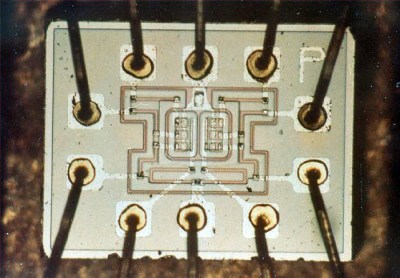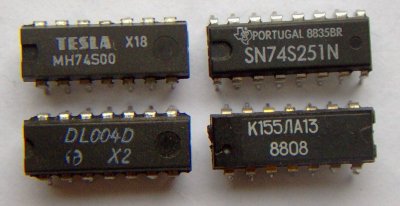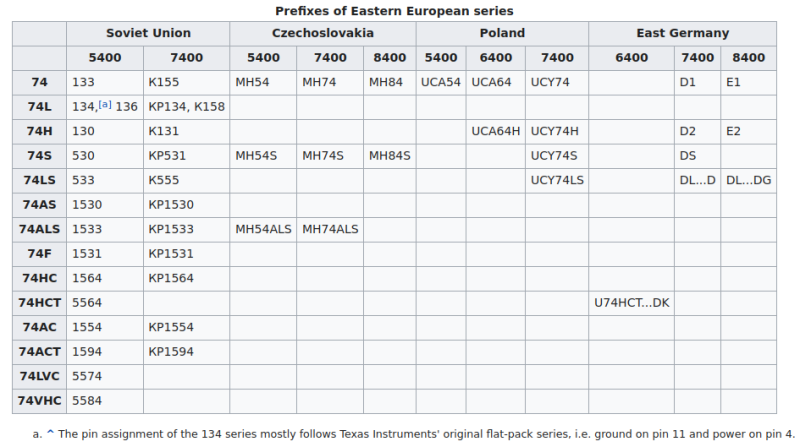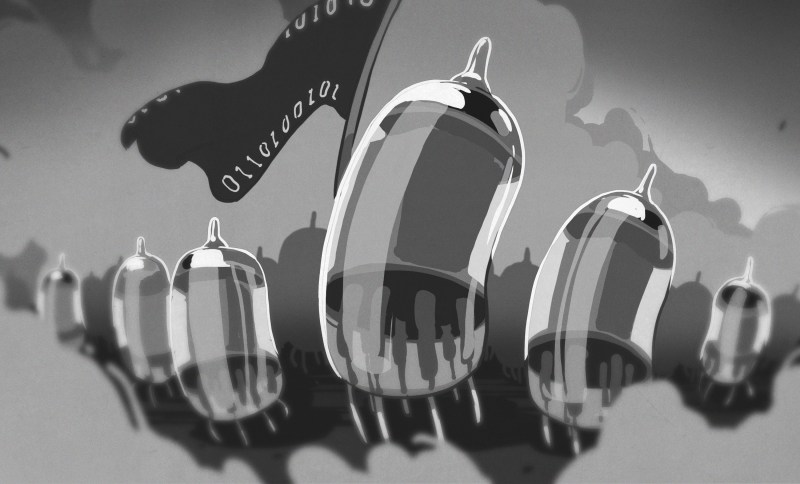When starting a new electronics project today, one of the first things that we tend to do is pick the integrated circuits that make up the core of the design. This can be anything from a microcontroller and various controller ICs to a sprinkling of MOSFETs, opamps, and possibly some 7400- or 4000-series logic ICs to tie things together. Yet it hasn’t been that long since this level of high integration and miniaturization was firmly in the realm of science-fiction, with even NORBIT modules seeming futuristic.
Starting with the construction of the first point-contact transistor in 1947 and the bipolar junction transistor (BJT) in 1948 at Bell Labs, the electronics world would soon see the beginning of its biggest transformation to that point. Yet due to the interesting geopolitical circumstances of the 20th century, this led to a fascinating situation of parallel development, blatant copying of designs, and one of the most fascinating stories in technology history on both sides of the Iron Curtain.
A Smorgasbord of New Tech

After the invention of the transistor, it was of course not a simple matter of just slapping some transistors on a silicon die to create logic gates, putting it into a plastic (or ceramic) package, and taking over the world of digital electronics.
The first viable approach for creating logic gates with transistors in the early 1960s was resistor-transistor logic (RTL), which limited the number of transistors needed. At the time, resistors were cheaper and transistors were still hard to make. This approach was used with the Apollo Guidance Computer, which was built using discrete 3-input RTL-based NOR gates.
The competing diode-transistor logic (DTL) circuit technology had the advantages of using less power and allowing for significantly more fan-in (the number of supported inputs to a circuit), as well as for relatively easy increase of fan-out (number of outputs) by using additional diodes and transistors. A disadvantage of DTL was that the propagation delay through a circuit is relatively long due to the charge stored in the base region of the transistors.
This led to a number of attempts to control this saturation issue, including an added capacitor, a Baker clamp and the Schottky transistor. The early 1960s saw the release of DTL-based logic chips, with Signetics’ SE100 series, followed by Fairchild with the 930-series DTμL (micrologic) series. Following DTL was transistor-transistor logic (TTL), which is fairly similar to DTL, but as the name suggests, uses only transistors.
The first commercially produced TTL micrologic chips were Sylvania’s Universal High-Logic Level (SUHL) and the successor SUHL II series. Texas Instruments (TI) would introduce the 5400 TTL series for military applications in 1964, with two years later the 7400-series introduced for general applications.
Somewhat in parallel, emitter-coupled logic (ECL) also saw continuous success into the 1980s. The main advantage of ECL over approaches like RTL and DTL as well as TTL is that ECL is very fast due to its emitter-following nature, using a single overdriven bipolar junction transistor (BJT). The design is such that none of the transistors used are ever in saturation, with small voltage swings between high and low levels (0.8 V) that allow for relatively fast switching times.
Although ECL has the disadvantages of requiring relatively complicated power supplies with low noise, and drawing constant current, its high switching speeds made it an obvious choice in mainframes and other applications where speed was the most important factor. This included the Cray-1 super computer, as well as a range of IBM and VAX mainframes.
This contrasts with the development of the MOSFET (metal–oxide–semiconductor field-effect transistor), which saw its basic working principles already proposed in 1926, but took a much longer time to become ready for commercialization than the BJT, even though MOSFETs offer significant size and scaling advantages over these. Yet when MOS technology became ready for mass-production in the late 1960s, it caused a small revolution that enabled not just the still common 4000-series CMOS logic chips (introduced by RCA in 1968), but also the microprocessors that would power the home computer revolution of the 1970s.
Checking in with the CIA
Probably little of the preceding history is unfamiliar to the average reader, but where things get interesting is with the development of these technologies in the Soviet Union and allied nations. As this part of the world was on less-than-friendly relations with the US and allies since the 1940s, it got largely left out of the big semiconductor revolution that was taking place primarily in the US.
Essentially this meant that the manufacturing equipment and know-how for manufacturing transistors and MOSFETs was under strict embargo, with First World countries being forbidden from exporting any such items into the USSR and allied territories. When we look at a top secret 1976 CIA document (declassified in 1999) titled USSR Seeks to Build Advanced Semiconductor Industry With Embargoed Western Machinery, we can get a good impression of what the state of things were at that point in time.
Even as the US, Europe, and Japan were ramping up their respective semiconductor industries, the USSR was lagging severely behind. Although USSR leadership recognized the massive tactical advantage that modern semiconductor technology would give them, this was not a disadvantage that they would easily overcome. This led to a large-scale effort by the USSR to illicitly import Western machinery for manufacturing cutting-edge semiconductors and copy whatever technology they could get their hands on.
The Joys of Standards

Some of the result of this can be found in the many logic ICs that are compatible with 7400-logic series TTL ICs. While the European manufacturers would follow the Pro Electron naming scheme (e.g. FJH101 for the 7403 8-input NAND gate), the Soviet and to some extent Eastern Bloc manufacturers used the Soviet IC designation scheme. This began with the NP0.034.000 standard in 1968 which saw its first update in 1973 with GOST 18682—73.
Notable with IC logic chips produced for the Soviet market is that they use metric pin spacing (2.5 mm and 1.2 mm) rather than Imperial (2.54 mm and 1.27 mm). In Eastern Bloc countries like Czechoslovakia, Poland, and East Germany, various IC designation schemes were used, with many of them matching the Western equivalent. In East Germany, for example, three 7400 compatible series existed — 6400, 7400 and 8400 — each targeting a different market with different temperature ranges and other properties.

Even more confusingly, logic chips designated for export would sometimes be marked using the US-style 7400 designation. The use of Cyrillic lettering instead of Latin characters can also be very confusing, especially when a Cyrillic and Latin character look similar. The continued production of these series of logic ICs after the dissolution of the Soviet Union in 1991 at semiconductor plants which may not offer the printing of Cyrillic characters – forcing the use of romanized characters – has further muddled the naming here.
Transforming Iron into Silicon

For the people who lived in the USSR or any of its satellite nations, much of the technological revolution of the 1960s through the 1980s went largely by unnoticed. Due to the lack of semiconductor manufacturing capacity in the USSR, the ICs that got produced mostly found their way into military equipment and related, leaving lesser and outdated ICs for the average citizen, also resulting in valve technology surviving in the USSR for decades beyond in much of the West.
Yet with the fall of the Soviet Union, this all changed. With the embargoes against the USSR no longer in place, consumer goods filled with Western ICs flooded the markets in Eastern Europe and Russia, causing the rapid demise of companies like the Czechoslovak Tesla, which had been manufacturing pretty much all electronics for the local market there.
Military and other long-term contracts ensured that both the Soviet IC naming scheme and special ICs survive to this day, but the exciting days of spy-versus-spy of the Cold War have passed, leaving behind an oddly split history that will no doubt confuse many for decades to come.















PLEASE.
Do use the right words.
It was the German Democratic Republic. (1949-1990)
None of the devaluating ahtefull dumb speach.
No East Germany,
no soviet satellite or what so ever.
Thanks
Using the colloquial name for any country is better than using the official name. Often times it’s questionable at best if a country is “Democratic”, a “People’s Republic” etc.. Using the colloquial name lets you avoid spreading an incorrect image.
Are you suggesting that the Democratic People’s Republic of Korea might not be a democratic people’s republic, and it’s better call them North Korea?
Have you any doubt? In Spain we say: Even a monkey is dressed in silk, is just a monkey.
And, even if the silk is being worn by a monkey, it’s still silk. :)
Next you’ll be telling us that the movie “Top Secret” doesn’t actually exist.
I am no Ossie, but wasn’t it the DDR?
Why is “East Germany” “devaluating ahtefull dumb speach”. East is just a direction and both were Germany right? Here I’m not arguing, I’m asking. Educate us.
On the other hand I suspect that in the English speaking world there are many readers who would recognize “East Germany” but would have to Google “German Democratic Republic”. Most of whom would not bother and so might understand less of the article.
And really anything’s name is whatever people call it right? https://www.polysyllabic.com/?q=navigating/intro/prescriptive
I’m assuming it depends on where you were. If you were in East Germany, you likely didn’t call it that. Even apart from specific name, it had been Germany and remained Germany after it was split out by outside forces. So why use an external name for it?
If you weren’t in East Germany, the name makes more sense.
” East is just a direction”
East, West, just points on a compass, both equally as stupid as the other.
I offered my services to the Americans, they refused, now both sides can pay.
Sure thing. Just as soon as everyone in the world starts exclusively referring to the US as the “United States of America”. No more calling it the US, USA, America, the states, the colonies, etc., right?
We’re all intelligent people here, and we all knew exactly what the author meant. There’s no need for pedantry.
“It was the German Democratic Republic”
Which many, especially those born since 1990, would think was West Germany or the current reunified Germany based upon the BS inclusion of “Democratic” in that name.
Names aren’t semantic. They’re labels. Life gets simpler and less confusing once that principle is realized.
Ahh I remember the 4000 series fondly, much wider tolerance for power supply than the 7400’s and you could do nifty things like touch switches as the input impedance was so high.
4011 was my favourite. Could do anything a 555 could!
And don’t forget our local group : https://hackaday.io/project/8449-hackaday-ttlers
And a little less work than TTL for LED display. Example 555 and 4017 to make chasing LED vs 555, 7493, and 74138 or 74154 to get the same.
I still have a huge CMOS and TTL databook from late 80s somewhere, it’s how I searched for specific function before internet became easy
Daaaaamn, that 2.5mm pitch can be a pain…
When there are only a few pins in row, you can easily coerce them into 2.54mm pitch breadboard but this is not viable for larger packages.
I have a piece of Polish lab equipment here that has a Soviet 8080 clone CPU in a 2.54mm-pitch socket. It fits, but *only just*.
Long reliance on vacuum tubes wasn’t only because of delays in modern semiconductor manufacture. It was widely believed that next war will be nuclear, and they wanted to be certain that military electronic devices will survive nuclear EMP.
Modern testing suggests that tubes have no particular advantage here, and that design of the actual electronics device is the most important. But 50s and early 60s semiconductors did not inspire much confidence, having often inferior characteristics vs. vacuum tubes.
EMP resistance is a myth. For example T-55AM Merida tank had its fire control system (SKO-1) and laser designation detector (WPL-1) designed with TTLs, not tubes. It cannot be denied that T-55 tanks were designed to operate in shadow of mushroom clouds looming over what would formerly be West Germany, France or Denmark.
Supposedly, besides being surprised by the Mig-25 using steel instead of titanium construction, the West was surprised by its use of tube electronics when the defector Lt. Belenko flew his Mig-25 to Japan. Those who disassembled it before returning it to the Soviets (in pieces) when they demanded its return claimed that at least that made it more resistant to EMP. The plane was created to attack the US high altitude, Mach 3 XB-70 which was never fielded, but because of that intended target the Mig-25 still holds many performance records to this day.
I remember when that happened. And I always wondered if it was deliberate, or EMP was used to explain the tubes. If you were stuck with old technology, wouldn’t you make it sound like an advantage?
Take it for what it’s worth (not much), but the AN/PRC-77 turned out to be substantially more EMP-resistant than the AN/PRC-25. The PRC-25 was transistorized, but used a tube final, due to difficulties with manufacturing reliable power transistors at the time. A few years later, the product-improved PRC-25 was adopted as the PRC-77.
As part of the changeover, the Canadian government apparently required EMP certification of the new radio. The PRC-25 had failed, but was exempt, but the new PRC-77 would be required to pass certification. Surprisingly, the -77 passed with flying colors. This was apparently surprising enough to the engineers that they validated the pulse generator and re-tested both radios. The -25’s final amplifier failed again, rendering it receive-only, but the -77 remained fully functional, with no loss of performance.
There were other minor differences between the two models (the field-replaceable modules were slightly reworked based on observations from active-duty deployment), but none that were relevant to EMP-resistance.
When not plugged into a large-scale power grid, antenna, or telephone infrastructure (all of which act as giant antennas), the main factor is the breakdown voltage of the final amplifier and any RF filter components.
Surprisingly, many vacuum tubes don’t really handle really high-instantaneous-voltage spikes well, while for a transistor, breakdown voltage is just another characteristic, and is simply subject to normal engineering design tradeoffs.
It turns out it’s much harder to design a vacuum power amplifier tube with benign cascade voltage breakdown characteristics without compromising its figures of merit AS a power amplifier. A solid-state transistor optimized to handle serious power is also very hard to damage with the voltage differential that can be generated in a man-portable antenna. A vacuum tube, on the other hand, tends to temporarily become a conducting plasma-state device, at the same time it’s being fed serious power. The result is melted filaments and grids, and often melted or distorted plates.
I’ve always wondered if a nuvistor would suffer the same plasma damage, but have never been able to find a nuvistor rated for use as a power amplifier.
In 1963 and 1964, I was a senior electronic tech. at Friden’s Rochester, NY R&D lab. MECL was new. Westinghouse made DTL, their 930 series. Packages were flat packs, top & bottom gold plated metal, perhaps Kovar. White ceramic between the top and bottom surrounded gold–plated ribbon leads.
They looked a bit like wee ice cream sandwiches.
I no longer remember, but I think lead pitch was 0.05″. Leads came out of the ends of the package, too.
Feature size was so large that a stereo microscope could let you see circuit lay(out and details. Chips were embedded in gold, probably pure.
Each IC cost $50.00. If we dropped one on the floor, we surely searched until we found it!
I made a few logic circuits out of them, using surface mount (!)
•=•=•
Our lead engineer called me into his office to show me sample prototypes of what they were calling Dual Inline Packages. Back then, they could have had one more lead on one side, making backward insertion impossible.
=•=•=
I completely skipped the era of small–scale integration, and never learned how date codes in 1974 were not confused with type numbers in the 7400 series.
In 2012 or 2013 one of the teachers at Bialystok University of Technology lectured us about basic/introductory digital logic using CEMI UCY7400 series chips and their datasheets as a core of the course. I know 7400 chips are 7400 chips regardless of who makes them but still… Me and two other guys who actually dabbled in electronics before, had a good laugh when we watched other classmates (around 30 of them) making serious notes about chips from mid 70s produced by long-gone state-owned enterprise during communist times. References and recommened reading was also Polish books from 70s and 80s. I understand some books may be timeless but ffs it was 2010s already! What’s truly astonishing is that this lecturer was in his late 30s maybe early 40s and not some grandpa from 1950s.
By the end of the course it was clear why the guy became an academic teacher. With his “knowledge” finding employment on free market would be quite a challenge (unless he lowered his expectations and went for something like being a truck driver or construction worker).
7403 is a quad open-collector 2-input NAND gate. 7430 is an 8-input NAND gate.
I went to Lithuania in the early 90s, on a business trip with IBM. We were looking to sell IBM technology to the Ministry of Informatics, to help bridge the gulf between the technology they had left over from the days of the Soviet Union, and the rest of the world. Dave Brown from the UK, Mickey Coggins from Austin, TX – the land of AIX, and PowerPC and I flew to Vilnius, and met with the Minister and a number of his entourage. There were companies that manufactured DEC clones, IBM PC clones, and IBM MVS clones distributed around the former Soviet Union; Lithuania had some part in that business – semiconductor manufacture, I believe. That they made machines that worked at all was amazing given they had to make their own chips from schematics published in data books. There was one factory in Vilnius that was making some kind of chip (1.2 um process), for which after the fall of the Soviet Union there was no market, but thanks to the 100% employment practice, it was still making chips. I don’t know if we ever had a chance with PowerPC, but it was a very, very entertaining business trip and hugely enlightening about what life was like before.
Hah, Tesla a.s., Czechoslovakia and Elon Musk’s Tesla Inc., U.S.A. have butted heads:
* Tesla (Czechoslovak company), Dispute with Tesla, Inc.
https://en.wikipedia.org/wiki/Tesla_(Czechoslovak_company)#Dispute_with_Tesla,_Inc.
Somewhere around the time when TTL was just about to get cheap enough for non-military use, Signetics introduced their “Utilogic” family. Some outputs could only source; some could only sink. Some inputs needed to be driven up, some pulled down. The result was that a NAND gate could not drive another NAND gate, and a NOR couldn’t drive another NOR. Flip-flops were a nightmare. To top it off, the chips drew a lot of power and ran very hot. I tried to do a design with it, gave up, and went for TTL on the promise of the Texas Instruments field engineer that the price would drop before we got into production. He was telling the truth, and the design was successful.
I worked with an old Russian who ran across the border when you still had to. He was Metrologist at a the factory we worked and designed and built all the calibration and test equipment for the factory.
I ordered a bag of 200 2N3904’s for I think $0.05 each.
He said “this is what I love about this country!”. He said to get a single transistor back home, he had to do a design accounting for every parameter in the 2 inch thick data sheet for that transistor, submit it and get it approved. Then you wait months. When it comes you test that one transistor and redesign your circuit to use what you got.
I had to find unijunction transistors for him.
I used to kid him that you Russians beat the west into space building out of the junkyard. (That was a compliment). We kept the technology from them, but they were still incredibly resourceful.
Thanks for mentionong NORBITs; I used them back in the late 60s but had forgotten their name. Experience with them got me a job working with 930 series DTL and 7400 series TTL and kick started a 45 year career in computer hardware and software.
There were an amazing number of (largely) incompatible logic families. This article and its comments only cover *some* of the many variations.
We’re incredibly lucky that an informal “TTL compatible” standard emerged. Can you imagine what things would be like if every micro, memory, and peripheral chip needed be sourced in a dozen different versions for RTL, TTL, CMOS, HTL, ECL, etc? Half the chips in a design would be level converters!
That is a beautiful stained glass window.